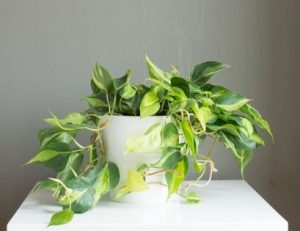
Houseplants are beautiful and they can add color and life to your home. Not only that, but having plants in your home can also be great for reducing stress and boosting your overall health.
In this article, we will discuss some common houseplants, what they look like, and what care they need so you can choose the right one for you.
14 Common Houseplants
Let’s begin with our list! All of these plants are perfect in their own way but vary in their requirements. Make sure you research well before buying one so that you can care for it appropriately and watch it grow!
1. Philodendron
The first on our list is the philodendron. This plant is often confused with pothos, as both belong to the same family of Araceae. However, a major difference between the two is that philodendron’s leaves are uniformly green!
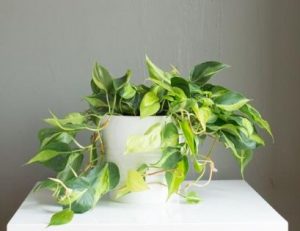
Philodendron requires minimal care and is amongst the popular houseplants for beginners. Place the plant in a bright location that has ample indirect sunlight. It requires watering once a week during the active growth phase in spring and summer. It’s also a great idea to mist them twice a week as they prefer high humidity. In winter, you must water it once every 10 days. The right temperature for the plant is between 70-80 ºF during the day and above 55º F at night. With the right care, the plant can grow 2 to 3 feet tall.
2. Christmas Cactus
Christmas cactus or Schlumbergera is one of the most popular indoor plants that can be pink. Its beautiful flowers will add the perfect dash of color to your home during the winter months! When taken care of, the plant can grow up to 10 inches tall with a diameter of 24 inches. It prefers a temperature of between 60-65 ºF.
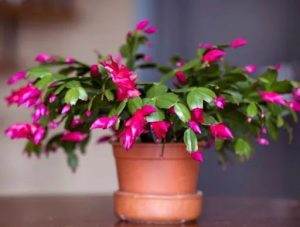
Just because it’s called a cactus doesn’t mean it should be placed in direct sunlight for long hours. It only requires moderate light with occasional direct sunlight. You should water it once every two to three weeks but check to see that the top one-third of the soil is dry before watering. This indoor plant also requires a good fertilizer every two weeks during spring, and once a month during winters and fall.
3. Areca Palm
Next on our list of common indoor plants is the areca palm (Dypsis lutescens). This indoor plant is known for its large size as it can grow up to 6 or 7 feet and has large leaves! It is widely used as part of the interior design and you will often find this plant in malls, cafes, and even homes.

The most important thing you should pay attention to is the watering requirements of this plant. Water it enough to keep the soil moist during spring and summer but let it slightly dry in fall and winters. Make sure you’ve planted this palm in a pot with drainage holes. This plant needs bright indirect sunlight and a temperature between 60 and 75 ºF, so make sure to place it near a window. Trimming the leaves is also required from time to time.
4. Aloe Vera
Aloe vera (Aloe barbadensis Miller) is not only amongst the common household plants but is also known for its various health benefits. It is a short plant with thick, green, and glossy leaves that can grow up to 2-3 feet. Its juice can be applied on wounds for healing! However, it is not a suitable houseplant if you have cats or dogs as its juice is harmful to them if eaten raw and can cause nausea and indigestion.
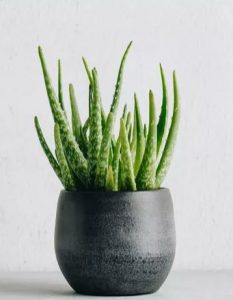
Direct sun can harm this plant, so make sure to place it in a place with indirect sunlight. It does not require frequent watering, and you should only water it if the soil feels dry to the touch. It should also be placed in a pot with a drainage hole as its roots can rot in water. The ideal temperature required is 60 to 75 ºF.
5. Spider Plant
The spider plant or Chlorophytum comosum is amongst the most popular houseplants. It is very easy to grow and is the perfect houseplant for beginners. Its long green and white leaves can grow up to 12 to 18 inches long when placed in the right humid environment.

These plants grow well in warm climates with temperatures between 55 and 65 ºF. You should water it when the soil feels dry to the touch. Regular misting helps to maintain the humidity necessary for this plant. Place it in bright indirect sunlight near a large window for the best results!
6. Pothos – Devil’s Ivy
Pothos, devil’s ivy, or Epipremnum aureum is a common houseplant mainly because it’s very easy to maintain. It is also one of the most affordable houseplants that are widely available on the market. It has variegated leaves in shades of green, yellow, and white. With new species being developed, you can find lots of varieties of pothos on the market!

Devil’s ivy likes bright, indirect sunlight but can tolerate low light conditions as well. This is the ideal plant that can be placed in that dark corner of your room! It prefers temperatures between 65 and 75 ºF. Water pothos when the soil feels dry to the touch. The plant may require frequent trimming as it can grow up to 50 feet (15 meters) long!
7. African Violets
African violets (Saintpaulia ionantha) require a bit more care than other common types of houseplants. When taken care of, the plant will bloom abundantly with white, violet, pink, or blue flowers and can grow up to 12 inches in height or more!
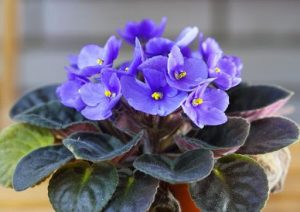
To understand how to care for this plant, think of the climate in the African jungle. That’s where it is from originally and creating the same conditions will help this plant remain healthy.
Place it in bright, filtered light with a temperature between 65 and 75 ºF during the day with a 5 to 10 degree drop during the night. You should also keep the soil moist and use room temperature water when watering this violet-like plant.
Key Takeaways
|
8. Anthurium
Next on our list of popular home plants is Anthurium or Anthurium andraeanum. This beautiful plant bears red flowers and is very easy to maintain. If you’re trying to add colors to your home’s interior, growing anthurium is a good first step! The average height of anthurium stems is 12 inches but they can grow up to 18 inches!
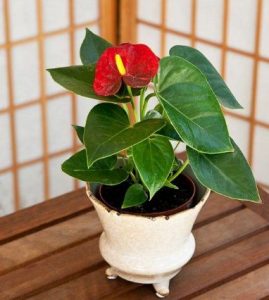
This plant requires a temperature between 65 and 85 ºF. Like most indoor plants, it requires bright indirect sunlight. It should be watered when the soil feels dry to the touch; overwatering must be avoided as it can cause the roots to rot.
9. Lucky Bamboo
As the name siggests, lucky bamboo (Dracaena sanderiana) is considered lucky in many cultures and is a popular gift, which is why we’ve included it on our list of the most common indoor plants. It is a small plant with an average stem length of 4 inches, making it perfect for placing on a table or on a kitchen shelf.

This plant needs only a little amount of indirect light. If its green and white leaves begin to turn brown, it’s getting too much light. The plant requires an average temperature of 64-75 °F. You should also keep it watered at all times, adding fertilizers monthly in spring and summer only if the water becomes discolored.
10. Jade Plant
The jade plant (Crassula argentea) is amongst the popular houseplants of 2022. It is short, can be maintained easily, and is perfect for beginners. When taken care of, it produces leaves of green and white color and its stem can grow up to 11 inches.

This plant likes a warm temperature between 64 and 75 °F with good light all year round regardless of the season. You can use grow lights for these types of houseplants that require ample light throughout the year. To make the jade plant grow better, keep the moisture in check and never let this plant dry out completely.
11. Rubber Tree
Despite its name, rubber tree or Hevea brasiliensis is one of the most common large houseplants as well as a popular outdoor plant! It has green leathery leaves and a stem height of 20 feet. Make sure you purchase it when it’s small so that it can adapt better to indoor conditions.
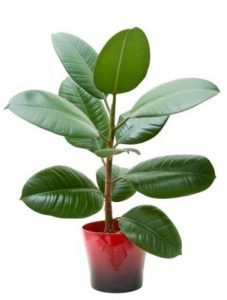
It requires bright indirect or filtered sun and a temperature between 65 and 85 ºF. Keep its soil moist, but avoid overwatering as it can make the roots rot. You should also wipe its leaves with a damp cloth at least once a week for proper growth.
12. Begonia
Begonia belongs to the Begoniaceae family and it’s a beautiful, flowering plant that can be found in many different types of colors. It is a popular houseplant. Its foliage can be green, pink, white, or salmon and its stems can grow up to 12 to 18 inches.
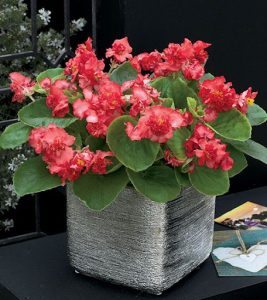
The plant requires temperatures of 55 to 65 °F during the day, and 50 to 55 °F at night. You should keep the soil moist but not soggy. Keep it in moderate indirect light; it can tolerate direct morning light, too.
13. Weeping Fig – Ficus Benjamina
Weeping fig or Ficus Benjamina is a fast-growing, thick, bushy, and large houseplant that has shiny dark green leaves. Its stem’s height can reach up to 20 feet and it’s one of the most common potted plants. It needs a lot of space due to its large size.
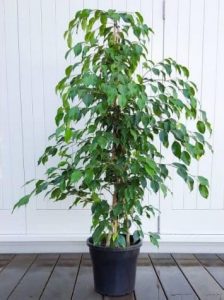
The plant requires 60-80 °F during the day, and 55 to 60 °F at night. Keep the soil moist but not soggy to avoid gnats as they are difficult to get rid of. The plant requires bright indirect sunlight and can do well with a little morning sun too!
| DID YOU KNOW: Weeping fig is the most popular houseplant in the state of Arizona, while aloe vera is pretty common in most other states! |
14. Lemon Lime Dracaena
Lemon-lime dracaena (Dracaena fragrans) is a beautiful indoor plant that has long neon yellow and dark green colored leaves doing justice to its name. It can grow up to 15 feet when fully mature and is also quite resistant to pest attacks.
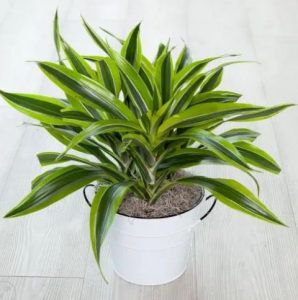
Most common household plants require indirect sunlight, and lemon-lime is no exception. It likes medium indirect light and a temperature between 60 and 75 °F. Allow the top 1 inch of the soil to get dry before watering again to prevent root rot.
Conclusion
Many different types of plants do well as houseplants. It is important to know the temperature, water, and light requirements for each plant in order to provide the best care. You should also know what the plant looks like to make sure you’re choosing a plant that will look good in your home. Follow these guidelines to choose the right houseplants for your home or office.
